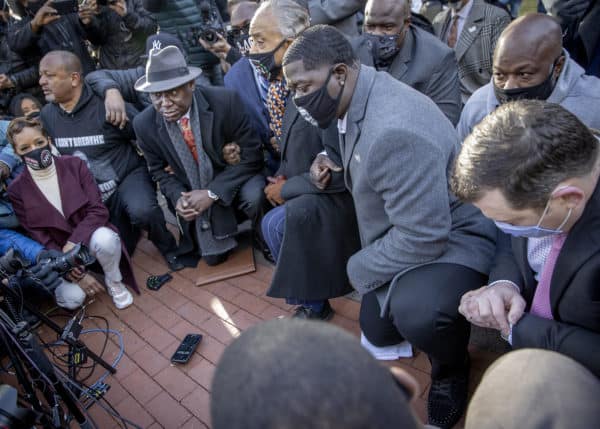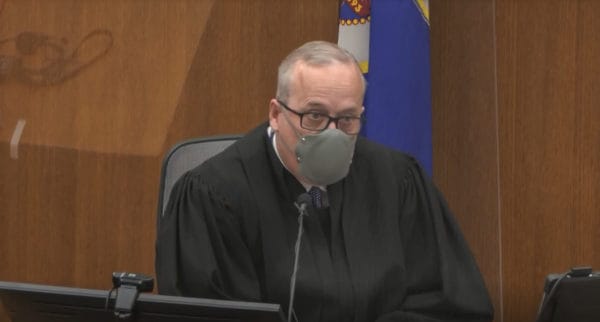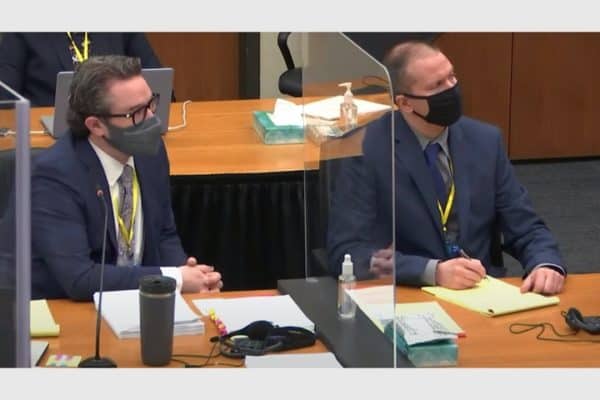The Derek Chauvin Trial — Day One
Anastasia Katz, American Renaissance, March 30, 2021
Former Minneapolis police officer Derek Chauvin’s murder trial began yesterday, accompanied by all the expected theatrics.
Reverend Al Sharpton has held several press conferences recently, accompanied by members of George Floyd’s family and their attorney Ben Crump, who represented them in the civil suit against the city of Minneapolis, which resulted in a $27 million settlement. On Sunday, Rev. Sharpton spoke at a Baptist Church in Minneapolis, saying “Chauvin is in the courtroom, but America is on trial.”
On Monday morning, Rev. Sharpton again stood before the press and called George Floyd’s death a “lynching by knee.” He led those assembled as they took a knee for eight minutes and 46 seconds — the time that former Minneapolis police officer Derek Chauvin restrained Floyd. Some of those surrounding Mr. Sharpton were wearing facemasks with “8:46” and a flatlined heartbeat printed on them. The group then chanted, “No justice! No peace!”

March 29, 2021, Minneapolis, Minnesota: Surrounded by family, Ben Crump and Al Sharpton took a knee for 8 minutes and 46 seconds after a press conference on the grounds of the Hennepin County Government Center. (Credit Image: © TNS via ZUMA Wire)
Mr. Crump said this would be “a referendum on how far America has come in its quest for equality and justice for all,” and would determine “if we live up to the belief that all men are created equal.” One of George Floyd’s brothers told the press, “If we can’t get justice for a black man here in America, we will get justice everywhere else in America. This is a starting point.”
Inside the courtroom, the trial started with the prosecution’s motion to prohibit the defense from suggesting that George Floyd had been “malingering” which is “the act of intentionally feigning or exaggerating physical or psychological symptoms for personal gain.” Judge Peter Cahill informed both teams that it would be okay to say that George Floyd “appeared to be resisting,” but not that he “was resisting.”

Hennepin County Judge Peter Cahill. (Credit Image: © B4859 / Avalon/Avalon via ZUMA Press)
The trial is being televised, but the jurors aren’t. During the selection, only jurors’ voices were broadcast, and they were assigned numbers to protect their identities. According to Court TV, the 12 jurors and two alternates are six men and nine women; ten under 50 and five over 50; eight whites, four blacks, and two who identify as multiracial.
The prosecution’s opening remarks were made by black lawyer Jerry Blackwell. He showed the jury the Minneapolis Police Department’s motto: “To protect with courage, to serve with compassion.” He told them that MPD officers take an oath that says they will never employ unnecessary force. Mr. Blackwell told the jurors, “You will learn what happened in that nine minutes and 29 seconds, the most important numbers you will hear in this trial are 9:29, what happened in those nine minutes and 29 seconds when Mr. Derek Chauvin was applying this excessive force to the body of Mr. George Floyd” — a number that did not match the “8:46” touted by Rev. Sharpton and the Floyd family earlier.
Mr. Blackwell then quoted what Floyd said as he lay on the ground in handcuffs, and said of Mr. Chauvin’s actions: “He doesn’t let up and he doesn’t get up.” He said that Derek Chauvin maintained his position with his knee on Floyd’s neck, even as he was told that Floyd did not have a pulse, and that Mr. Chauvin did not get up when a paramedic examined Floyd.
Mr. Blackwell said that “in your custody” is equivalent to “in your care,” and went through a list of witnesses he plans to call to demonstrate that Mr. Chauvin “did not administer care.” These witnesses will include:
- A use-of-force expert from Los Angeles.
- A police officer who was present at the scene and felt Mr. Chauvin used excessive force.
- Minneapolis Police Commander Katie Blackwell (no relation to Jerry Blackwell), who will testify about Mr. Chauvin’s training.
- A firefighter who wanted to take Floyd’s pulse and care for him.
- Minneapolis Chief of Police Medaria Arradondo, who will say that Mr. Chauvin’s actions were excessive force.
- Bystanders who saw Floyd’s arrest.
- Several experts, such as doctors, toxicologists, and a medical examiner.
Mr. Blackwell expressed sympathy for police officers in general, saying that they have difficult jobs and need to make split-second decisions, but that “9:29” was not a split second decision. He then gave a “trigger warning” before playing the video of Floyd’s arrest, explaining that people in the video would be called as witnesses. Derek Chauvin seemed calm as the video played, alternating between watching the screen and writing on his notepad. When the video ended, Mr. Blackwell told the jury that bystanders were calling the police on the police. He told them about another witness who would be called, a 911 dispatcher who also “called the police on the police.”
Regarding the cause of Floyd’s death, Mr. Blackwell told the jury, “You can believe your eyes.” He added that experts will explain that “compression for 9:29 is enough to take a life.” and that further video evidence will show that Floyd died of oxygen deficiency, not a heart attack. Drawing attention to the autopsy report that described cardiopulmonary arrest as the cause of death, Mr. Blackwell said, “All that means is the heart stops . . . [it’s] another way to say death. Cause of death is death.”
Mr. Blackwell denied that Floyd died from an opioid overdose. Acknowledging that Floyd had heart disease, Mr. Blackwell said Floyd lived for years with the condition — until “9:29.” He concluded his opening statement by describing George Floyd as a “Covid survivor” whose life meant something to other people.
Derek Chauvin’s lawyer is Eric Nelson, who is contracted to defend police officers in Minneapolis. He began his opening statement outlining the concept of “reasonable doubt” and stated, “There is no political or social cause in this courtroom.” He also told the jury, “This case is about more than nine minutes and 29 seconds.” There had been an extensive FBI investigation, search warrants, and interviews with first responders and nearly 400 witnesses.

Defense attorney Eric Nelson and defendant Derek Chauvin. (Credit Image: © Star Tribune / TNS via ZUMA Wire)
Mr. Nelson outlined what happened to bring Floyd to the attention of the police in the first place. A cashier at Cup Foods noticed that Floyd was using a fake $20 bill to pay for cigarettes. He asked Floyd twice to either pay for his cigarettes with real money or give the cigarettes back. Floyd refused, so the cashier called the police. The employee noticed a problem with Floyd’s behavior, and reported that he thought Floyd was under the influence of drugs or alcohol.
Mr. Nelson told the jury they would hear about what happened in Floyd’s Mercedes Benz before the police arrived: Floyd took two pills and passed out. Two of his friends were in the car with him, and they panicked when they couldn’t wake him up. One called her daughter and asked her to come pick them up. The police arrived first, and Mr. Nelson claimed that bodycam footage will show that the officer who first drew a weapon on Floyd did so after Floyd refused to show his hands. When confronted by police, Floyd put drugs in his mouth to conceal them.
“When an officer responds to what is sometimes a routine and minimal event,” Mr. Nelson said, “It often evolves into a greater and more serious event.” Two search warrants were executed on Floyd’s car, revealing pills known as “speedballs,” which are manufactured to have the appearance of Percocet, but are a mixture of uppers and downers. Partially dissolved pills — found in the squad car that Floyd refused to sit in — contain Floyd’s DNA.
Mr. Nelson contrasted Mr. Chauvin’s build (5’9” and 140 pounds) with George Floyd’s (6’3” and 223 pounds), and told the jury that they will see bodycam footage with conversations between the officers that the bystanders who filmed the event on their phones did not hear.
Mr. Nelson said the police officers made two calls for emergency medical care; the first was a call regarding Floyd’s injured nose, and the second was a “Code 3,” which heightened the urgency. When paramedics arrived, they did a “load and go” because of the angry crowd of bystanders at the scene. Floyd was quickly put in the ambulance, and paramedics began resuscitative efforts several blocks away. There were additional attempts to save Floyd at the hospital, but he was pronounced dead that evening.
Nelson said the only person who conducted an autopsy on Floyd was Dr. Andrew Baker, and he told the jury they will hear about interviews Dr. Baker had with law enforcement about his conclusion. Floyd had no telltale signs of asphyxiation, such as bruising to the neck, even beneath his skin, and no petechial hemorrhaging. There is no evidence that his airflow was restricted. Blood toxicology revealed the presence of Fentanyl and methamphetamine. Nelson described Floyd’s heart and lung issues, and revealed that Floyd had a paraganglioma tumor that secreted adrenalin.
On the actual cause of death, Nelson said, “Evidence will show that George Floyd died of a cardiac arrhythmia that occurred as a result of hypertension, coronary disease, the ingestion of methamphetamine and Fentanyl, and the adrenalin flowing through his body. All of which acted to further compromise an already compromised heart.” Therefore, he concluded that the only reasonable verdict would be to find Derek Chauvin not guilty.















